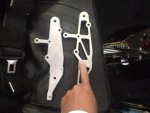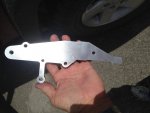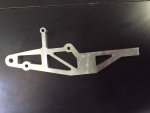You are using an out of date browser. It may not display this or other websites correctly.
You should upgrade or use an alternative browser.
You should upgrade or use an alternative browser.
Seriously, MTO Failed Prerotator bracket at 70hrs
- Thread starter HydroGyroNut
- Start date
HydroGyroNut
Hydro
Adjustment Of Air Valve
Adjustment Of Air Valve
Hi Capt Gyro,
Tried to adjust this air valve as you described and don't see any difference in time of engagement. Seems like both engage at about the same time. Any suggestions?
Adjustment Of Air Valve
What you want to see is the Bendix engage before the belt. Have someone push the prerotator button with the key on, but the engine off. As he does this observe both the Bendix and the belt tensioner. If the Bendix does not engage prior to the belt tensioner turn it counterclockwise a 1/4 turn at a time. Does not take much of an adjustment. Hope this helps Victor. BTW, you probably don't remember but my wife Terry and I met you and your lovely mother last year at Benson Days. Stephen
Hi Capt Gyro,
Tried to adjust this air valve as you described and don't see any difference in time of engagement. Seems like both engage at about the same time. Any suggestions?
GyrOZprey
Aussie in Kansas.
- Joined
- Aug 8, 2011
- Messages
- 3,396
- Location
- Whitewater KS
- Aircraft
- Butterfly Aurora N5560Z / Titanium Explorer N456TE & N488TE/ - trained in MTOsport 446QT/488FB
- Total Flight Time
- 1023
Buy a handful of valves ....
Buy a handful of valves ....
It seems these valves have a functional variance between units ..... when having issues on initial set-up on our gyro we were advised to try several different valves until we found the one that worked best!!!
We were even sent a unit that had an electrical 3 sec delay solenoid that activated the line to the bendix pin-ram for a couple of secs before allowing air flow to the belt ram ..... nice idea but extra complexity allowed more fail points - so we found the valve that worked best & have stuck with that! :yo:
Buy a handful of valves ....
Hi Capt Gyro,
Tried to adjust this air valve as you described and don't see any difference in time of engagement. Seems like both engage at about the same time. Any suggestions?
It seems these valves have a functional variance between units ..... when having issues on initial set-up on our gyro we were advised to try several different valves until we found the one that worked best!!!
We were even sent a unit that had an electrical 3 sec delay solenoid that activated the line to the bendix pin-ram for a couple of secs before allowing air flow to the belt ram ..... nice idea but extra complexity allowed more fail points - so we found the valve that worked best & have stuck with that! :yo:
Steve McGowan
Gold Member
Hall Naw
Hall Naw
Leonardo's Fault
Hall Naw
Leonardo's Fault
Texasautogyro
Gyro Master Instructor
- Joined
- Aug 23, 2011
- Messages
- 1,755
- Location
- Tomball Texas
- Aircraft
- AutoGyro MTO Sport/Cessna 172
- Total Flight Time
- 6400 with over 2400 in gyro
I have had a couple of calls about more of these MTO brackets getting cracks. One on a factory machine with less then 40 hrs. If you would like a nice solid bracket made let me know ASAP! I can have one made for you. It is CNC milled and cost is about 200.00 plus shipping US dollars. I can ship Fed Ex about any place. I am not making anything on these. I just want to help. I am pointing to where they crack in the picture.
Attachments
Last edited:
Texasautogyro
Gyro Master Instructor
- Joined
- Aug 23, 2011
- Messages
- 1,755
- Location
- Tomball Texas
- Aircraft
- AutoGyro MTO Sport/Cessna 172
- Total Flight Time
- 6400 with over 2400 in gyro
Abid
AR-1 gyro manufacturer
- Joined
- Oct 31, 2011
- Messages
- 6,282
- Location
- Tampa, FL
- Aircraft
- AR-1
- Total Flight Time
- 4000+ 560 gyroplanes. Sport CFI Gyro and Trikes. Pilot Airplane
I don't know if it will fit but if it helps anyone, we use a similar bracket in AR-1 made from mild steel, zinc plated that has shown no tendency to crack or do anything in AG-1 or AR-1.
Its a regular production part for us and I have probably 20 in stock if anyone needs one, its $135.00 I cannot vouch if it fits on a MTO exactly etc. Unlike popular belief its not a direct copy. I believe there are differences (never checked) though Victor Agadzi was able to use it on his.
Its a regular production part for us and I have probably 20 in stock if anyone needs one, its $135.00 I cannot vouch if it fits on a MTO exactly etc. Unlike popular belief its not a direct copy. I believe there are differences (never checked) though Victor Agadzi was able to use it on his.
Attachments
Doug Riley
Platinum Member
- Joined
- Jan 11, 2004
- Messages
- 6,983
The "gold standard" way to build this thing, IMHO, is to weld it out of 4130 round tubing (or mild-steel tubing, if you prefer). The problems with the original are at least threefold:
(1) It's apparently aluminum alloy, which has poor fatigue qualities;
(2) It appears to be cut from aluminum plate, so that some load-bearing arms have grain running crosswise to the load; and
(3) some of its loads are bending moments.
Abid's version solves Problem #1. Steel can fatigue, too, but it has a definite fatigue strength (endurance limit), unlike aluminum, which breaks at very low loadings if it experiences enough cycles of vibration. A 5800 RPM Rotax piles up vibe cycles pretty fast.
A welded, triangulated framework of steel tubing allows us to line up the grain with the loads, and to load the elements of the assembly in tension and compression instead of the less efficient bending.
The downside is the higher labor cost, given the multiple steps need to create a finished weldment.
(1) It's apparently aluminum alloy, which has poor fatigue qualities;
(2) It appears to be cut from aluminum plate, so that some load-bearing arms have grain running crosswise to the load; and
(3) some of its loads are bending moments.
Abid's version solves Problem #1. Steel can fatigue, too, but it has a definite fatigue strength (endurance limit), unlike aluminum, which breaks at very low loadings if it experiences enough cycles of vibration. A 5800 RPM Rotax piles up vibe cycles pretty fast.
A welded, triangulated framework of steel tubing allows us to line up the grain with the loads, and to load the elements of the assembly in tension and compression instead of the less efficient bending.
The downside is the higher labor cost, given the multiple steps need to create a finished weldment.
chrisk
Gyroplane CFI
- Joined
- Jun 5, 2015
- Messages
- 440
- Location
- Round Rock TX
- Aircraft
- Magni M24, Turbo Mooney 231
- Total Flight Time
- 1000
Interesting. I didn't even think about the grain being an issue. Maybe this is part of the problem with the AG bracket. Maybe some are made with the grain in a less favorable direction if they are not paying attention to that.
Abid
AR-1 gyro manufacturer
- Joined
- Oct 31, 2011
- Messages
- 6,282
- Location
- Tampa, FL
- Aircraft
- AR-1
- Total Flight Time
- 4000+ 560 gyroplanes. Sport CFI Gyro and Trikes. Pilot Airplane
The "gold standard" way to build this thing, IMHO, is to weld it out of 4130 round tubing (or mild-steel tubing, if you prefer). The problems with the original are at least threefold:
(1) It's apparently aluminum alloy, which has poor fatigue qualities;
(2) It appears to be cut from aluminum plate, so that some load-bearing arms have grain running crosswise to the load; and
(3) some of its loads are bending moments.
Abid's version solves Problem #1. Steel can fatigue, too, but it has a definite fatigue strength (endurance limit), unlike aluminum, which breaks at very low loadings if it experiences enough cycles of vibration. A 5800 RPM Rotax piles up vibe cycles pretty fast.
A welded, triangulated framework of steel tubing allows us to line up the grain with the loads, and to load the elements of the assembly in tension and compression instead of the less efficient bending.
The downside is the higher labor cost, given the multiple steps need to create a finished weldment.
Actually, that bracket should never be in play at full power. Its only at play when you engage the pre-rotator which is usually starting from idle, squeezing the handle or in MTO's case pushing the pre-rotator grip switch till the belt engages completely and the unit becomes one (shakes disappear) and then slowly and smoothly increasing RPM to bring rotor RPM up.
The alpha value of mild steel is plenty to handle the loads it should see in normal operation forever. Aluminum has no alpha value and bending loads are worst on this structure. Those are what are causing the breaks. They have tried to solve it with a triangulated mechanism now to reduce the bending load. It may work.
Doug Riley
Platinum Member
- Joined
- Jan 11, 2004
- Messages
- 6,983
The bracket may not be carrying prerotation loads at full engine RPM -- but the bracket is still there during firewalled climbouts. It may be vibrating at a particular engine RPM like a saxophone reed, and heading toward fatigue.
Some of the prespin loads are bound to be across the grain, since the bracket has slender arms sticking out large angles to each other. The grain in sheet and plate stock is determined when it's made, and is marked on the stock.
A custom aluminum-alloy forging might be made with grain running in the various directions you want, but at great expense for a low-volume product.
Some of the prespin loads are bound to be across the grain, since the bracket has slender arms sticking out large angles to each other. The grain in sheet and plate stock is determined when it's made, and is marked on the stock.
A custom aluminum-alloy forging might be made with grain running in the various directions you want, but at great expense for a low-volume product.
Mark Humbke
Soaring Eagle
captgyro;n905763 said:What you want to see is the Bendix engage before the belt. Have someone push the prerotator button with the key on, but the engine off. As he does this observe both the Bendix and the belt tensioner. If the Bendix does not engage prior to the belt tensioner turn it counterclockwise a 1/4 turn at a time. Does not take much of an adjustment. Hope this helps Victor. BTW, you probably don't remember but my wife Terry and I met you and your lovely mother last year at Benson Days. Stephen
Regarding the above procedure I tried to see if the Bendix did engage before the belt..with the engine off..it did engage before the belt.. slightly...but the "pin ram" only came up to the bottom of the bendix surface but did not lift it up to the ring gear on the blades?? (the bendix is totally free to move)...After the Pre rotator cylinder was pressured (slightly after the pin ram) the belt tighten and" it then lifted the bendix up ...sometimes"
I guess the back pressure built up and lifted it?? But saying that...the blades started spinning and then sometimes they don't when I hit the prerotator button??
Another thing I notice beings I didn't have a helmet on and the engine wasn't running when I was doing this test there seemed to be a lot of air venting under the dash.. Is this common??
My MTO Sport 2015 has only 140 hrs on it..I had another MTO Sport 2009 and 600 hrs on it and never an issue with brackets or pre-rotaors.. different story now
I make sure both pulleys are aligned as best as is possible before I tighten the pre rotator bracket bolts to the motor..
Bottom line the pre rotator engages sometimes and then doesn't the next time..
Very Frustrating..
Thanks for All Comments..
loftus
Super Member
- Joined
- Mar 17, 2013
- Messages
- 1,346
- Location
- Ponce Inlet, Florida
- Aircraft
- Aircam; Previously owned Autogyro MTO
- Total Flight Time
- 800 hours
Well finally Autogyro have got rid of the old pre rotator mechanism altogether on the new MTO, using a similar mechanism to the Calidus and Cavalon. I have not heard of too many issues with that setup, so hopefully this will no longer be a problem.
Similar threads
- Replies
- 42
- Views
- 11K



